7 December, 2003
Ray’s Gully
Today is the “B-team’s” first full day on Mount Erebus after our long
wait in McMurdo and our two nights acclimatization on the Fang Glacier.
As it is a beautiful day here, we are looking to get a lot of
accomplished today. Since the sun never sets, we have ample time to be
out in the field each day.
On the agenda for today – five of us headed up Ray’s Gully on the east
side of the volcano. We rode Skidoos out to the gully and then drove up.
I was feeling pretty confident, despite my inexperience, right up to the
point where the Skidoo ahead of me rolled down the slope, throwing the
driver down ahead of it. Jackie, the hapless victim, scrambled to get
out of the way of the tumbling machine. As the Skidoo righted itself,
Jackie attempted to stop its runaway motion, but the machine succeeded
in breaking free and rolling all the way back to the bottom of the hill
(Figure 1). The Skidoos path narrowly missed one of the many sinkholes
that dot this area.
After rescuing the runaway Skidoo, we proceeded up Ray’s Gully on foot
to bury cables for a new seismic station that will be installed this
season. Two 2-man teams carried spools of electric cable up the side of
the mountain, a challenge due to the loose rocks and the high altitude.
We started at the power station low down in the gully (Figure 2) and
walked to the crater rim.
To my disappointment, the crater was obscured by the plume (Figure 3),
but Mount Terror (an extinct volcano on the east side of Ross Island)
was easily visible behind us (Figures 4 and 5). We spent about half an
hour at the rim hoping to see into the crater. With no luck in seeing
the lava lake, we headed home to repair the skidoo that was damaged in
the roll down the gully (Figure 6). As it was Sunday, there was no
chance of helicoptering a mechanic up to fix our problem, so Peter
Kelly, a graduate student at New Mexico Tech, took matters into his own
gloves. Popping the hoods on “Wolfgang,” the damaged skidoo, and “Maui,”
an operational vehicle, Pete compared the throttle cables on each,
discovering that “Wolfgang’s” had been damaged in the roll. A critical
component to a successful field season is the ability to troubleshoot
and improvise. With no prior knowledge of snowmobile mechanics, Pete
patiently worked his way through each possible problem until he found
the solution.
Despite the fact that the morning was clouded, by late afternoon, there
was no visible plume coming from Erebus. After dinner we headed back up
to the crater rim, this time from the northwest side. To our delight,
the crater was perfectly clear (Figure 7). We could see the lava lake
located on the floor of the inner crater and with careful observation,
we would make out red streaks across the lake, the result of the
continuous convection of the lake (Figure 8). The surface of the lake
cools and hardens as it is exposed to the cold air. Warmer lava then
pushes to the surface, moving the cooler lava away and cracking any
hardened surfaces. The colder material is pulled back down into the lake
and reheated. Occasionally, gas bubbles would rise to the surface and
pop. As this was the most dynamic activity visible from the rim, we were
all eager to see it. As we knelt at the edge of the crater rim we
appeared to be praying to the volcano gods for more mini-eruptions… or
else praying that this wasn’t the day for a big eruption!
Eventually the wind and cold drove us back down off the volcano, for the
day. But the image of the continuously connecting lava lake is burned
into all of our minds. This was a rare and perfect glimpse into the
throat of an active volcano!
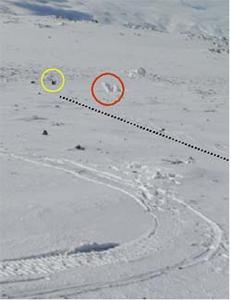
1. Figure 1 – On the snowmobile ride up Ray’s Gully, one snowmobile got away from us (yellow circle) and narrowly missed an ice tower with a nearby sinkhole (red circle). The tracks of the runaway machine are marked by the dotted black line – a little bit off of the established route visible in the foreground.
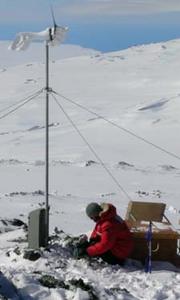
2. Figure 2 – Peter Kelly, a graduate student at New Mexico Tech, examines the condition of the power station at the bottom of Ray’s Gully. This station will power the seismometer that we are installing at the crater rim.
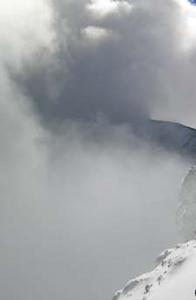
3. Figure 3 – On our first hike up the volcano, the crater was obscured by the plume. Brief breaks in the clouds allowed us to see glimpses of the lava lake below.
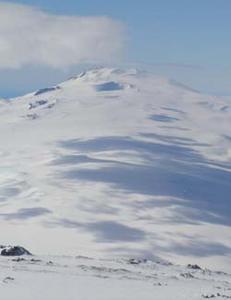
4. Figure 4 – Neighboring Mount Terror was easily visible from the rim of Erebus. Mount Terror is an extinct volcano located on the east side of Ross Island.
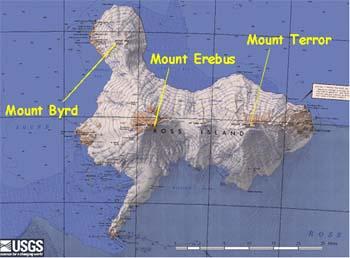
5. Figure 5 – Map showing the locations of Mt. Erebus, Mt. Terror, and Mt. Bird on Ross Island.

6. Figure 6 – Peter Kelly and Julie Calkins repair “Wolfgang,” the snowmobile damaged in the morning’s roll and runaway. A large part of working at any field site, but especially in Antarctica, is the ability to troubleshoot and improvise. As it was a Sunday, there was no way to get a mechanic up to Mt. Erebus so we had to fix the Skidoo on our own.
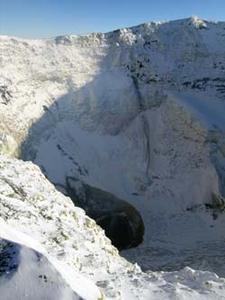
7. Figure 7 – By evening, the plume had disappeared and we were allowed a rare and magnificent view of the lava lake on the crater floor. The lake is approximately 45 m (150 ft) across, the inner crater is approximately 300 m (985 ft) across, and the main crater is almost 600 m (1,970 ft) wide.
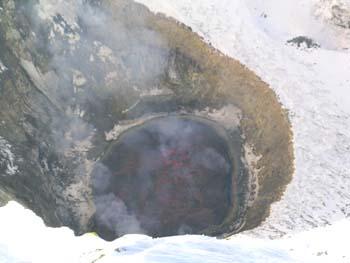
8. Figure 8 – Red streaks can be seen in the lake, evidence of the continuous convection (overturning driven by temperature differences). An occasional gas bubble would swell and burst, eliciting cheers from the observers.

9. Figure 9 – Praying to the volcano gods? Our team waits eagerly (kneeling and huddling in an attempt to get out of the wind) for the next gas bubble to pop in the lake. The convection of the lava lake is such a mesmerizing sight, I could have stayed for hours but for the wind.
Contact the TEA in the field at
.
If you cannot connect through your browser, copy the
TEA's e-mail address in the "To:" line of
your favorite e-mail package.
|
